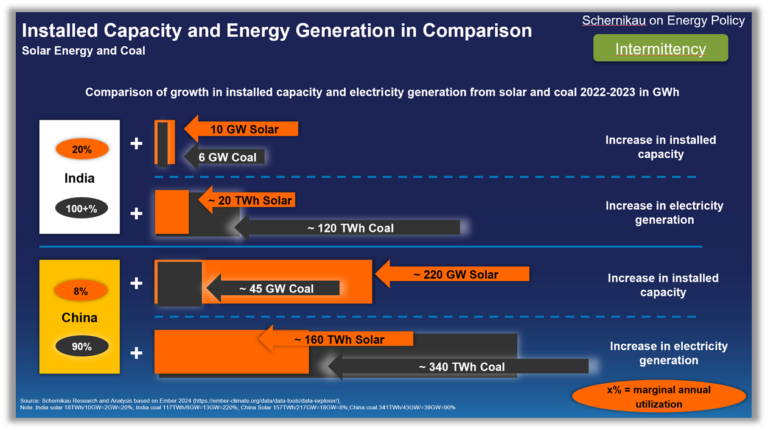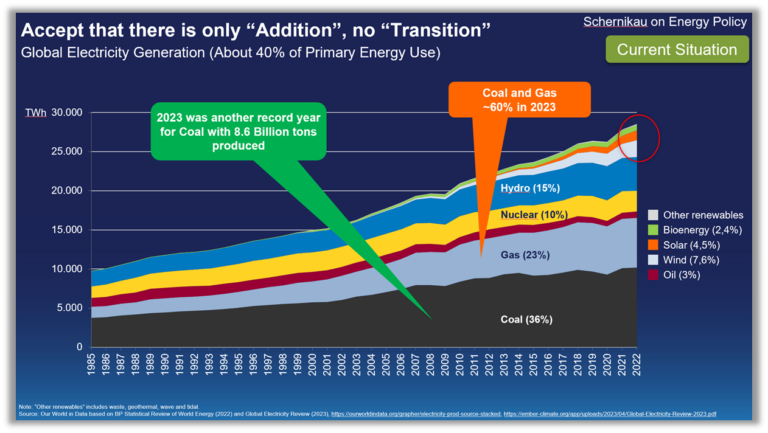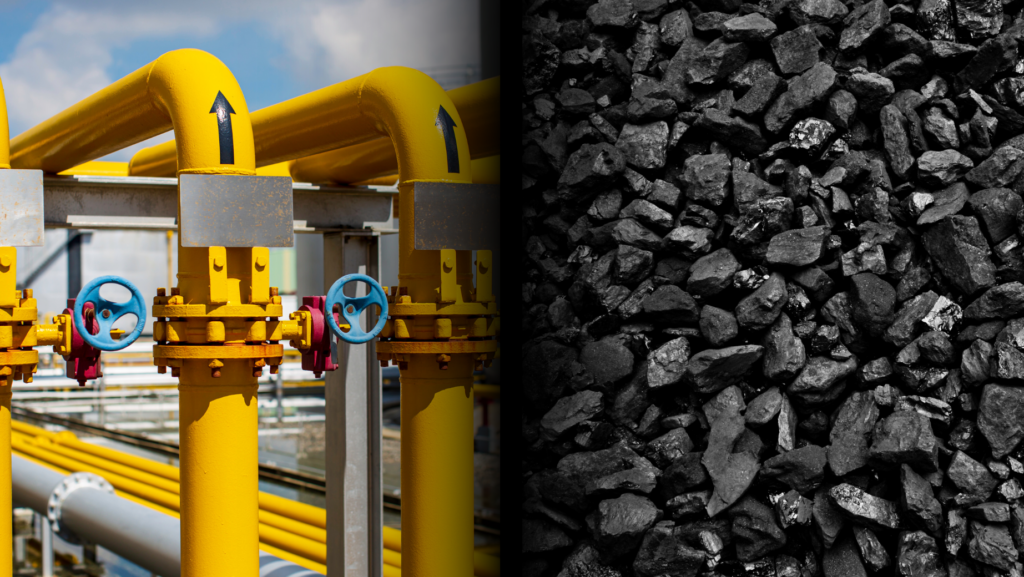Content
- What is gas, what is coal, and what do we use it for?
- The current “switching” sentiment: coal, gas, and hydrogen
- Lifecycle GHG emissions
- Economic future for coal and gas
Links and Resources (here you can find all links and sources mentioned in the article)
Where would the world be today or tomorrow without gas or coal?
Short answer: nowhere!
Coal and Gas make up 60% of global electricity and 50% of global primary energy. In China and India alone electricity from coal and gas account for about 65% and 75% respectively of the overall mix.
- In 2023 alone, China added over 40 GW of coal capacity and generated 340 TWh of additional electricity from coal (Solar: 220 GW added capa and 160 TWh added solar power)
- In the same year, India added 6 GW of coal capacity and generated 120 TWh of additional electricity from coal (Solar: 10 GW added capa, and 20 TWh added solar power, see Figure 1)
Most banks and government institutions support gas, but not coal as many scientific papers and most reports. They are modeling an economic pathway with “fewer emissions”, assuming that gas emits about half the “greenhouse gases” that coal does. Therefore, gas has been considered the “bridge towards the transition”.
Case in point of course, Germany. Germany’s energy policy towards so called “net-zero” relied on Russian gas to provide the “bridge” towards the desired “zero-emission future”. The Russian attack on the Ukraine put a forceful stop to that policy.
Liquified natural gas, LNG, reduces the dependence on pipelines and allows new suppliers and consumers to enter the market, making it seaborne. Southeast Asia and Europe, and so many more regions, started to take advantage of this new influx of “cleaner” fuel to power their thermal power plants
Then the year 2022 marked the big turning point. LNG prices skyrocketed, as Europe literally swept up the entire market and left close to “nothing” for developing nations. Heightened risks of grid failures in Bangladesh [1,2] and Pakistan [3] where just one of the many consequences.
Let’s have a look at Gas vs Coal. Is there a favorite? Can someone like me even answer such a question? Probably not completely unbiased, but let me try to give you a rundown in anyway… to allow you to form an informed opinion about coal and gas.
Figure 1: 2023 wind and solar additions in India and China
Coal and gas use an established, relatively simple technology for power generation consisting of boilers, turbines, and generators. Looking at combustion for power generation only, the key advantages of gas include:
- Gas burns cleaner than coal, leaving less residue and causing less particle emissions. Since gas is invisible, it also appears cleaner to transport
- Gas has a higher thermal efficiency than coal during combustion
- Gas power plants can be used as “peaker plants” as they ramp up and down in minutes, faster than coal, which may ramp up and down slightly slower
There are four key advantages of coal.
- Usually, not always, lower cost than gas (especially upfront investment and transportation/processing costs)
- Insignificant geopolitical concerns with reserves more evenly spread around the globe with difficult to control production and transportation (because of simplicity)
- Simple transportation (no pipelines, LNG terminals, regasification equipment, etc)
- High energy security, coal can be stored easily with less risk (no dependency on pipelines, no tanks required, no risk of explosion)
A CEO of a medium sized US utility that switched from coal to gas for economic reasons and under “ESG pressure”, recently summarized it as follows:
“Gas is great, but still… I used to have 4 months of energy supply in my backyard, today I wake up every morning praying that there is no problem with the gas pipeline, because I have millions of customers to serve every day. My energy security is far reduced”.
Let me reiterate that we need both gas and coal for our modern existence today and we will need it tomorrow. Personally, I am convinced that we need much more of both. The choice of coal or gas or both depends on each country’s specific geographical and geological situations, which makes it obvious why Saudi Arabia uses gas, India and China use coal, and why the US uses both.
However, I sense that the biggest misunderstanding about both coal and gas is their importance as a raw material input (nothing to do with energy). There is hardly any product that we use that does not require either both or at least gas or coal as a chemical “raw material” input (your phone, clothes, your car, food, your house, computers, solar panels, on and on it goes).
For example, the importance of coal for solar panels is summarized in my recent article “Coal’s importance for solar panel manufacturing”.
- What is gas, what is coal, and what do we use it for?
Natural gas or methane – simplified – is a hydrocarbon (CH4 ), consisting of one atom of carbon and four atoms of hydrogen. It is an energy dense gas, denser than hydrogen alone, and that is because of carbon. Carbon literally is a chemical miracle worker when it comes to hydrogen. Combined with hydrogen, carbon forms highly versatile and energetic “hydrocarbon” gaseous, liquid, and solid fuels (Figure 2). Higher carbon ratios yield solids and lower ratios yield gases, all possible at typical ambient temperatures and pressures. There is no need for complex equipment or pressure chambers.
Natural gas is considered a “fossil fuel” that developed from ancient plants and animals, tens to hundreds of millions of years ago. It is believed that both oil and natural gas originated from the remains of ancient marine organisms. Natural gas is extracted from underground reserves, often in combination with oil before it is “conditioned” for transport to the final consumer. Such conditioning may be as simple as preparing and sending it through a pipeline or as difficult as “making” liquified natural gas or LNG, a very cold and pressurized liquid form of gas. A “fun fact”, at −160°C the liquid gas volume reduces by a factor of about 600.
As per latest available resource information the from German BGR 2024 [19] we have over 200 years of known gas remaining potential available at current production rates. Remaining potential is the sum of known reserves and resources. Of course, new resources are being discovered continuously and technological advances continue to increase “the remaining life of fossil fuels”.
What is gas used for? Here are the main applications:
- Power generation (about 25% of global power comes from gas)
- Household heating and cooking
- Industrial heat (glass, cement, other product manufacturing)
- Feedstock for fertilizers (production of ammonia)
- Other raw material input (plastics, paint, pharmaceuticals, other products)
- Transportation fuel (i.e. compressed natural gas, CNG)
Coal on the other hand is a solid, largely consisting of the element carbon, mined from either underground or surface mines around the world, resulting in almost 9Bln tons p.a., making up almost 10% of all “raw materials” we mine or grow annually for human existence. Coal is also considered a “fossil fuel” that basically comes from very old trees and plants, pressurized under airtight conditions for tens to hundreds of millions of years.
Coal is one of the few raw materials that we mine that can be used as is, without further processing or cleaning. Regardless, a significant portion of coal is processed in so called “washeries” to reduce the ash (silica or sand) content to upgrade the coal and increase the carbon content.
The German BGR 2024 [19] global analysis states that we have over 2,000 years of known hard coal remaining potential available, and over 3,000 years of lignite coal, at current production rates. Remaining potential is the sum of known reserves and resources.
There are many types of coals, depending on how old the coal is and what the geological conditions of coalification were. On average, older coal is more valuable than younger coal, but it is not always true. Two main types of coal exist: (1) metallurgical coal including coking coal and anthracites, but there is more; and (2) coal that is used primarily for thermal applications, often referred to as thermal coal.
As such, the main uses for coal include the following:
- Power generation (about 35% of global power comes from coal)
- Industrial heat (glass, cement, other product manufacturing)
- Steel making (2/3rd of global 2 Bln tons p.a. of steel are only possible because of coal)
- Other raw material input through chemical reduction and other processes (silicon for computers or solar panels, chrome, nickel, aluminum and much more such as fly ash for cement products)
- Household heating (being phased out, rightly so)
- Source for critical minerals and fertilizer using humates
All chemical and physical details on coal can be accessed via Kindle or in print at “Schernikau’s Coal Handbook”
Figure 2: Fuels in a Thermodynamic System C-H2-O2; Conversion of Carbohydrate to Coal, Methane and Liquid Hydrocarbons
Source: Wolf 2021, from our book www.unpopular-truth.com (downloadable image available there)
2. The current “switching” sentiment: coal, gas, and hydrogen
The percentage of gas in the global electricity mix has been increasing over the past two decades from about 20% in 2004 to 25% in 2023. During the same time, coal’s share of electricity reduced from 40% to just over 35%. While both coal and gas continued growing in absolute terms (Figure 3) and retained their combined share essentially unchanged, this “switch” from coal to gas was driven by two reasons:
- Economic: low-cost fracking made additional abundant gas resources available especially in the US
- Political: the believe that gas has less “climate impact” than coal
Global Energy Monitor’s “Global Coal Plant Tracker” [17] – an anti-coal organization – noted that the number of countries with coal power under development (pre-construction and construction) has nearly halved from 75 in 2014 to 40 in 2024. China and India combined account for 86% of current development.
They also note that new coal-fired power station proposals continue to outpace cancellations. In the first half of 2024, over 60GW of coal capacity was newly proposed or revived, compared to the 34GW that was shelved or cancelled over the same period. China plans for 1.3 Bln annual tons of new coal mine capacity. So, coal is expanding! Despite this many governments and organizations predict peak coal by end of this decade… we shall see.
Gas is expanding even faster. Coal and gas have been “competing” for decades and gas is still favored by many governments. The gas industry, closely linked to the oil industry, is generally better funded for industrial policy and lobbying than coal. The gas industry has also specifically targeted coal in some of its advertising (Figure 4).
- In the pre-Russia energy communication in October 2021, the EU President van der Leyen said “Wind energy is very volatile… Alongside this, we need a stable source, nuclear, and during the transition, of course, natural gas”.
- As recent as September 2024, the European Commission [17, p26] writes that “Develop a comprehensive strategy at the EU level, coordinate with Member States on how to manage natural gas during the transition and on how to secure natural gas (from where, volumes and conditions) for the next 20 years.”
There appears to be two fundamental misunderstandings in the general media, among the population, and many political and industrial leaders, about coal and gas, namely:
- Misunderstanding 1: Coal and gas are interchangeable when it comes to energy and raw material resources, they clearly are not always.
- Misunderstanding 2: Gas is “better for the climate” than coal making it better suited as a “transition fuel”, see next section.
The interesting point is that sometimes gas is favored because there is a belief that Hydrogen will be the sustainable solution to long-duration energy storage, and gas power plants and transmission infrastructure may be more easily converted to hydrogen power plants than what coal power plant would. “The Hydrogen future” and gas’ role is a 3rd significant misunderstanding well summarized in the book “The Hydrogen Illusion” by Prof Furfari [4]. The fundamental misunderstanding is around the belief that hydrogen is sustainable, safe, and cost effective. I invite you to read my blog on Hydrogen.
Figure 3: Coal and gas growth as% of global electricity production
Source: Schernikau based on BP, Our World in Data, Global Electricity Review
One simple point I would like to make here is that since solar and wind cannot be “zero CO2 “, neither can hydrogen derived from excess or unutilized wind and solar. The value chain of hydrogen for storage includes “making” H2, storing H2, transporting H2 and then repowering H2. In all these steps about 65-80% of the input energy gets lost and dissipates in the form of low value, high entropy heat into the atmosphere (Figure 5). Thus, the CO2 footprint of wind and solar, when using H2 for storage, would multiply by a factor of 3 or 4! In addition, hydrogen is highly explosive, permeates practically everything including steel, and is thus a dangerous product to handle.
- for example, our yet unpublished research shows that the CO2 footprint is likely at the higher end or above of the IPCC AR6 range of 9-250 gCO2/kWh for solar power
- assuming 250 gCO2/kWh was correct, then a 4x increase due to hydrogen storage value chain’s energy “losses” would make solar power + H2 with 750 to 1.000 gCO2/kWh on par with “unabated” coal power plants
Even if H2 was a viable solution, which it is not, the development of a so called “hydrogen economy” does not initially require H2-ready gas power plants. Because (1) such H2-ready gas plants cannot yet be connected to the non-existing hydrogen grid, and (2) hydrogen sprinter and hybrid power plants would be well suited as well, not requiring gas [7].
- Interestingly, the cost of producing hydrogen from coal with CCUS (Carbon Capture Utilization and Storage) would be about three times less expensive than producing low-carbon hydrogen through water electrolysis [17]
In addition, to safeguard the fluctuating feed-in of renewable energy sources, consideration must also be given to the continuation of alternative technological developments such as large-scale storage systems. Until these are available, coal-fired power plants can easily take, and sometimes already do take the place of H2-ready gas turbines in securing the fluctuating feed-in of renewable energy sources [8]. Also, ammonia could be co-fired in coal-fired power plants as an H2 carrier [based on IEA].
FYI, China or India are not building gas-fired power stations but continue to build coal instead, I wonder why. It appears coal can very well be used as backup for solar?
3. Lifecycle GHG emissions
Many discussions in the media and press have been about the lifecycle greenhouse gas emissions of gas, especially LNG. Not too long ago, The New Yorker [5] summarized it to the point “A new analysis suggests that LNG exports may well be worse for the environment than burning coal.” The peer-reviewed research referenced is from Howarth 2023 [6].
The well-established fact is that, assuming the IPCC is correct about methane’s global warming potential GWP, the relatively higher methane emissions throughout the life cycle of natural gas and LNG – from production and transportation to usage (including leaks), often offset, and in many cases exceed, the CO2 emissions advantage that gas has over coal. If one is worried about imminent human greenhouse gas induced catastrophic warming then CO2 doesn’t matter but CO2-equivalent (CO2eq) matters… over the next 20 years. This metric the IPCC measures with its 20-year Global Warming Potential GWP20
For the record, I do not doubt that CO2 or CH4 (methane) are greenhouse gases. However, there remains scientific uncertainty and debate about the global warming potential and climate sensitivity of greenhouse gases. My detailed objection to IPCC’s GWP as well as the scientific debate and uncertainty on GWP cannot be detailed on this platform (see also [14]). For instance, Wijngaarden/Happer 2020 have analyzed GHG forcing in detail and conclude significantly lower climate sensitivities than those used by the IPCC.
In our own peer-reviewed research Schernikau/Smith 2022 “Climate Impacts’ of Fossil Fuels in Today’s Energy Systems” [7] we come to the same conclusion of gas not being “better for the climate” than coal, using data solely from the International Energy Agency (IEA in Paris) and the Intergovernmental Panel on Climate Change (IPCC in Geneva).
The main “novelty” is that we included the fact that only half the CO2 emissions from any source can contribute to warming of the planet. This is a fact that is confirmed by the IPCC, but forgotten by most, because more than half of CO2 is taken up by nature such as plant life and oceans, contributing to greening of the Earth. The global warming potential of CO2 is for molecules remaining in the atmosphere acting as “greenhouse gases”, not for those taken up by nature.
Another noteworthy study confirming that LNG is “not better for the climate” than coal was published by Prof Wodopia of Germany in 2023 [8]. He concluded “the net lifecycle greenhouse gas emissions of liquefied natural gas (LNG) from the USA or Qatar are compared with those of coal, taking sulphur dioxide emissions into account. When used in a simple-cycle gas turbine, they are higher than those of coal. In part-load operation, the results shift further in favor of coal.”
Countless additional studies make similar points, here some more examples:
- [9] Rosselot et al 2021: Comparing Greenhouse Gas Impacts from Domestic Coal and Imported Natural Gas Electricity Generation in China,
- [10] Mar et al 2022: Beyond CO2 Equivalence: The Impacts of Methane on Climate, Ecosystems, and Health,
- [11] Kemfert et al 2022: The Expansion of Natural Gas Infrastructure Puts Energy Transitions at Risk,
- [12] Nature 2022: Scientists Raise Alarm over ‘Dangerously Fast’ Growth in Atmospheric Methane,
- [13] IEEFA 2020, The Australian LNG Industry’s Growth – and the Decline in Greenhouse Gas Emissions Standards,”
- [14] Alvarez et al 2018, Assessment of Methane Emissions from the U.S. Oil and Gas Supply Chain.
- [15] Howarth, Robert W. “Howarth 2024: The Greenhouse Gas Footprint of Liquefied Natural Gas (LNG) Exported from the United States.” Energy Science & Engineering n/a, no. n/a (October 2024)
4. Economic future for coal and gas
Understanding more about gas and coal, their importance for our energy needs and daily products used, but also their environmental impact, helps us make smarter energy policy decisions. I see that it is undisputed that coal and gas are on par when it comes to “the climate”. My opinion on the fallacy of measuring everything with CO2 is published here “The Dilemma of pricing CO2“.
Muttuti et al 2023 [20] pointed out in Nature Climate Change some more interesting facts about the envisioned “energy transition” away from coal which gives you a glimpse of the unrealistic nature of “net-zero pathways”:
- “… the pace of global [coal] phase-out proposed in techno-economic optimization models may be “at the limits of societal feasibility”… “twice as rapid as that achieved historically for any power technology in any country…”.
- On model bias: “… the application of too many constraints can lead to the modeller effectively steering the model towards their prejudged (realistic) pathway”
The future of coal and gas therefore appears to be brighter than it appears, because (1) the demand for carbon and hydrogen sourced from coal and gas cannot be easily replaced when it comes to the production of our day-to-day products, and (2) because alternative ways of producing grid-ready power are either significantly more expensive and/or have a much worse impact on the environment.
For more details on energy costs please refer to my article “The Energy Trilemma” from earlier this year.
The fact that we need to continue investing in our coal and gas supply chains, power plants, and material use infrastructure, appears to be obvious.
Consider this – assuming coal and gas have a 40% power plant efficiency on average, then a global 1% efficiency improvement results in 2.5% (1/40%) less raw material used and less environmental impact. Isn’t this worth the investment? Remember that coal and gas make up almost two thirds of the world’s power generation!
Investments, especially for coal but also for gas, are not keeping up with demand and this will logically lead to power shortages and inflated prices. That in turn will lead to energy poverty and less GDP growth. Has anyone counted the cost to humanity from such personal and economic losses? I fear not.
Links and Resources
[1] Reuters: Bangladesh’s Worst Electricity Crisis in a Decade, June 2023, sec. Asia Pacific. https://www.reuters.com/world/asia-pacific/bangladeshs-worst-electricity-crisis-decade-2023-06-07/.
[2] Reuters: Bangladesh Plunged into Darkness by National Grid Failure, October 2022, sec. Asia Pacific. https://www.reuters.com/world/asia-pacific/large-parts-bangladesh-without-power-after-national-grid-failure-daily-star-2022-10-04/.
[3] Reuters: Pakistan Suffers Big Power Outage after Second Grid Failure in Three Months, January 2023, sec. Asia Pacific. https://www.reuters.com/world/asia-pacific/pakistan-suffers-major-power-outage-after-grid-failure-2023-01-23/.
[4] Prof Furfari, book “The Hydrogen Illusion” 2022, https://www.amazon.com/hydrogen-illusion-Samuel-Furfari/dp/B08KHGDZNS
[5] New Yorker: On Methane – A Smoking Gun for Biden’s Big Climate Decision, November 2023. https://www.newyorker.com/news/daily-comment/a-smoking-gun-for-bidens-big-climate-decision
[6] Howarth 2023: The Greenhouse Gas Footprint of Liquefied Natural Gas (LNG) Exported from the United States,” October 2023,
[7] Schernikau and Smith 2022 ‘Climate Impacts’ of Fossil Fuels in Today’s Energy Systems’, SSRN Electronic Journal, March 2022. https://doi.org/10.2139/ssrn.3968359
[8] Wodopia 2024: Lifecycle Emissions From Gas and Coal Do Not Support a Coal-to-Gas Shift.” SSRN Scholarly Paper. Rochester, NY, January 2024. https://doi.org/10.2139/ssrn.4674204
[9] Rosselot et al 2021: Comparing Greenhouse Gas Impacts from Domestic Coal and Imported Natural Gas Electricity Generation in China.” ACS Sustainable Chemistry & Engineering 9, no. 26 (July 2021): 8759–69. https://doi.org/10.1021/acssuschemeng.1c01517
[10] Mar et al 2022: Beyond CO2 Equivalence: The Impacts of Methane on Climate, Ecosystems, and Health, Environmental Science & Policy 134 (April 2022): 127–36. https://doi.org/10.1016/j.envsci.2022.03.027.
[11] Kemfert et al 2022: The Expansion of Natural Gas Infrastructure Puts Energy Transitions at Risk, Nature Energy, July 2022, 1–6. https://doi.org/10.1038/s41560-022-01060-3.
[12] Nature: Scientists Raise Alarm over ‘Dangerously Fast’ Growth in Atmospheric Methane, Nature, February 2022. https://doi.org/10.1038/d41586-022-00312-2
[13] IEEFA 2020, Institute for Energy Economics & Financial Analysis, “IEEFA Brief: The Australian LNG Industry’s Growth – and the Decline in Greenhouse Gas Emissions Standards,” April 2020. http://ieefa.org/ieefa-brief-the-australian-lng-industrys-growth-and-the-decline-in-greenhouse-gas-emissions-standards/.
[14] Alvarez et al 2018, Assessment of Methane Emissions from the U.S. Oil and Gas Supply Chain.” Science 361, no. 6398 (July 2018): 186–88. https://doi.org/10.1126/science.aar7204.
[15] Howarth, Robert W. “Howarth 2024: The Greenhouse Gas Footprint of Liquefied Natural Gas (LNG) Exported from the United States.” Energy Science & Engineering n/a, no. n/a (October 2024) https://doi.org/10.1002/ese3.1934
[16] Wijngaarden/Happer 2020: Dependence of Earth’s Thermal Radiation on Five Most Abundant Greenhouse Gases.” arXiv:2006.03098 [Physics], June 2020. http://arxiv.org/abs/2006.03098
[17] based on IEA and other data, summarized by FutureCoal https://www.futurecoal.org/coal-facts/
[18] The Future of European Competitiveness, European Union, Sep 2024,
[20] Muttitt et al 2023: Socio-Political Feasibility of Coal Power Phase-out and Its Role in Mitigation Pathways.” Nature Climate Change, Feb 2023, https://doi.org/10.1038/s41558-022-01576-2.







